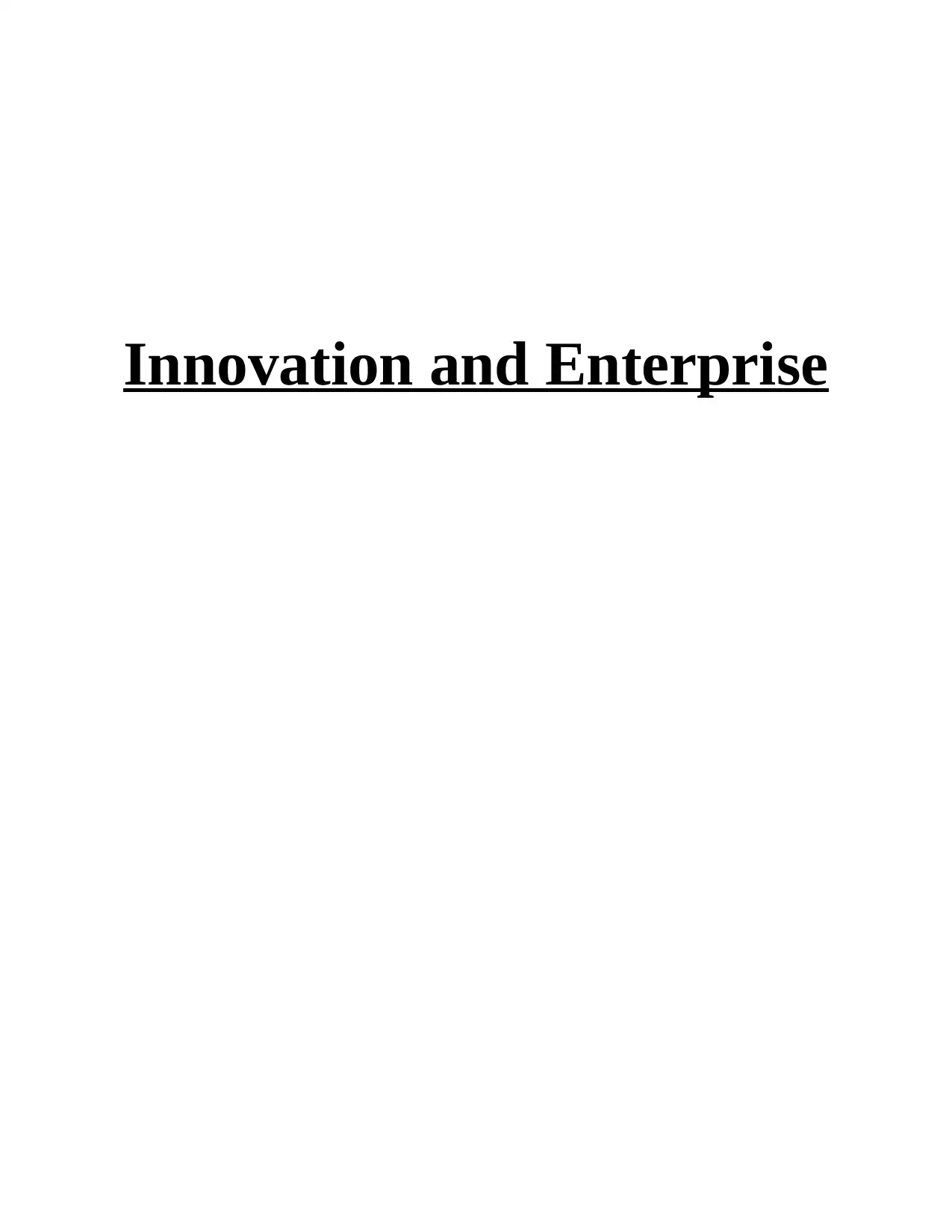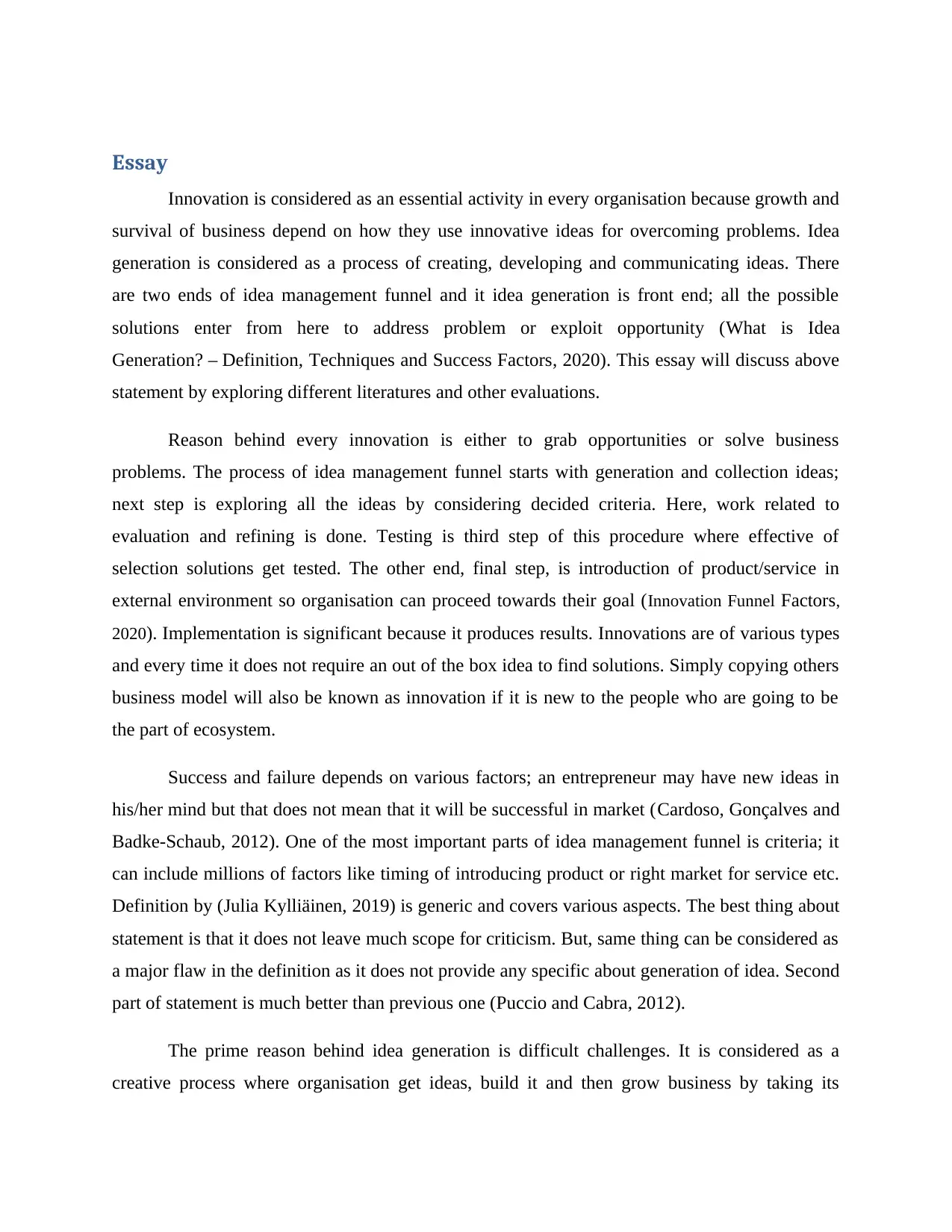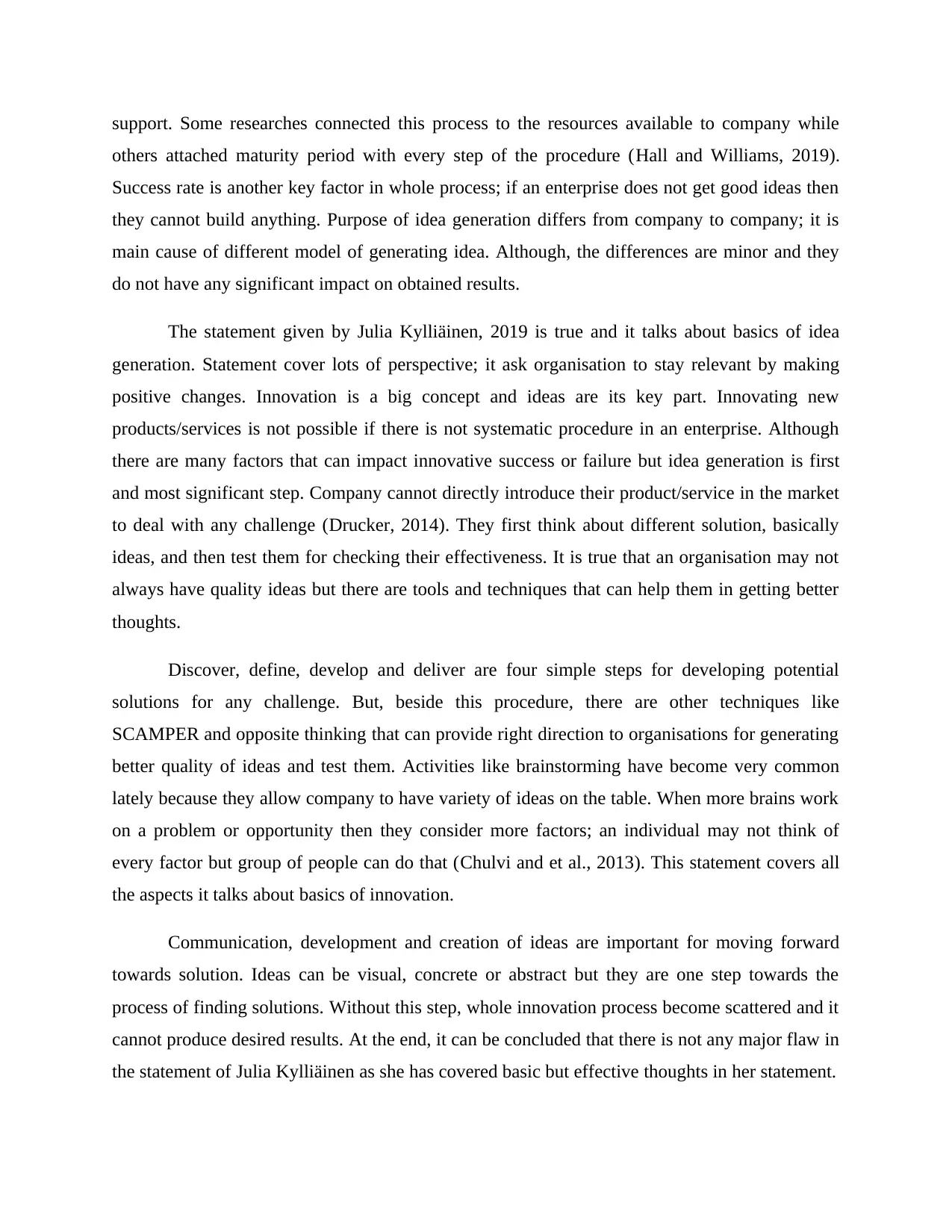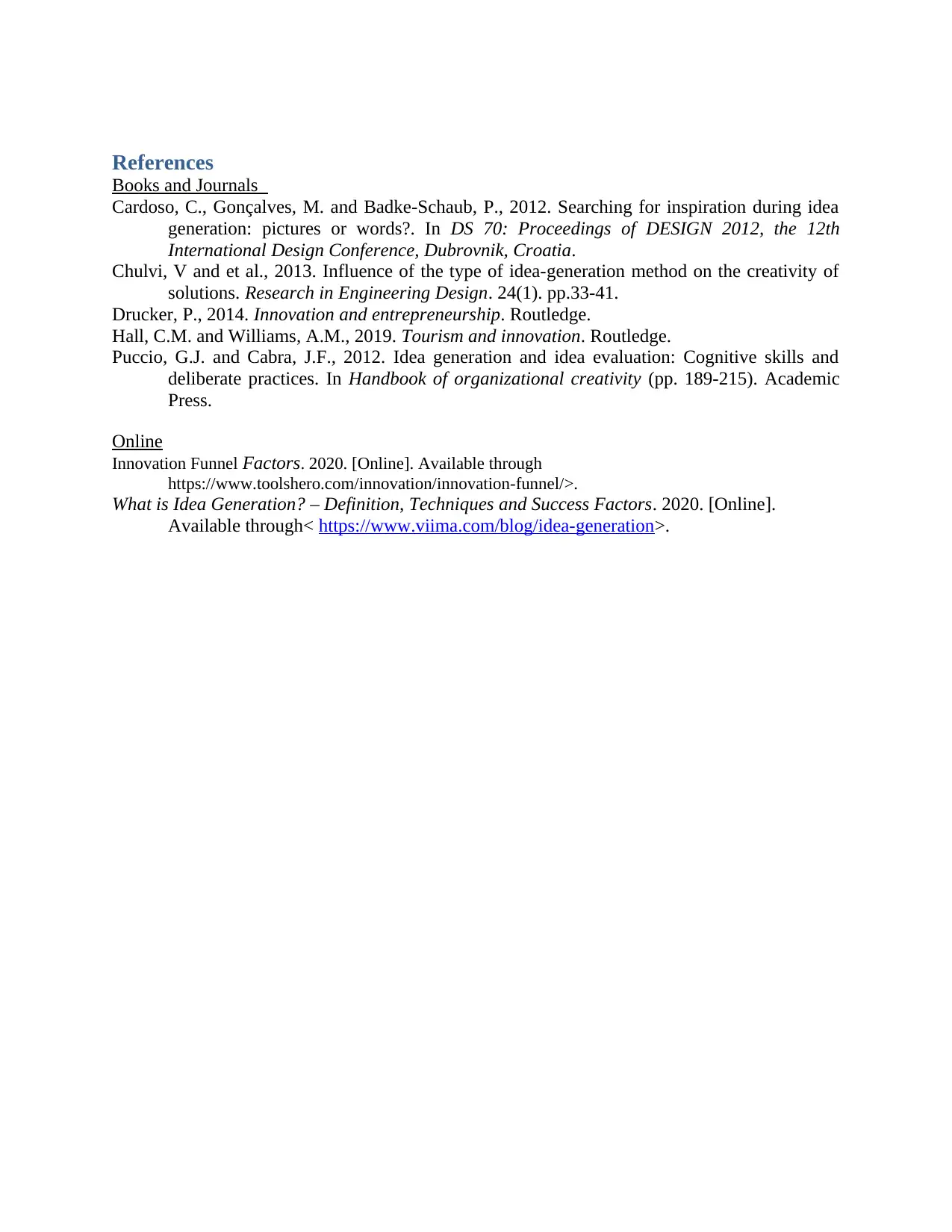Essay on Innovation and Enterprise: Idea Generation and Management
VerifiedAdded on 2023/01/11
|5
|1086
|83
Essay
AI Summary
This essay delves into the critical role of innovation and idea generation within organizations, emphasizing their significance for business growth and problem-solving. It explores the idea management funnel, from initial idea generation to product implementation, highlighting the importance of criteria, evaluation, and testing. The essay discusses different types of innovation, the importance of adapting to the market, and the tools and techniques for generating and refining ideas, such as brainstorming and SCAMPER. It analyzes the views of various authors, including Julia Kylliäinen and Drucker, to provide a comprehensive understanding of the innovation process and its impact on enterprise success. The essay concludes that while innovation is essential, a systematic approach to idea generation is the most significant step for achieving successful outcomes. The essay provides a detailed overview of the content and offers a valuable resource for students studying entrepreneurship.

Innovation and Enterprise
Paraphrase This Document
Need a fresh take? Get an instant paraphrase of this document with our AI Paraphraser

Essay
Innovation is considered as an essential activity in every organisation because growth and
survival of business depend on how they use innovative ideas for overcoming problems. Idea
generation is considered as a process of creating, developing and communicating ideas. There
are two ends of idea management funnel and it idea generation is front end; all the possible
solutions enter from here to address problem or exploit opportunity (What is Idea
Generation? – Definition, Techniques and Success Factors, 2020). This essay will discuss above
statement by exploring different literatures and other evaluations.
Reason behind every innovation is either to grab opportunities or solve business
problems. The process of idea management funnel starts with generation and collection ideas;
next step is exploring all the ideas by considering decided criteria. Here, work related to
evaluation and refining is done. Testing is third step of this procedure where effective of
selection solutions get tested. The other end, final step, is introduction of product/service in
external environment so organisation can proceed towards their goal (Innovation Funnel Factors,
2020). Implementation is significant because it produces results. Innovations are of various types
and every time it does not require an out of the box idea to find solutions. Simply copying others
business model will also be known as innovation if it is new to the people who are going to be
the part of ecosystem.
Success and failure depends on various factors; an entrepreneur may have new ideas in
his/her mind but that does not mean that it will be successful in market (Cardoso, Gonçalves and
Badke-Schaub, 2012). One of the most important parts of idea management funnel is criteria; it
can include millions of factors like timing of introducing product or right market for service etc.
Definition by (Julia Kylliäinen, 2019) is generic and covers various aspects. The best thing about
statement is that it does not leave much scope for criticism. But, same thing can be considered as
a major flaw in the definition as it does not provide any specific about generation of idea. Second
part of statement is much better than previous one (Puccio and Cabra, 2012).
The prime reason behind idea generation is difficult challenges. It is considered as a
creative process where organisation get ideas, build it and then grow business by taking its
Innovation is considered as an essential activity in every organisation because growth and
survival of business depend on how they use innovative ideas for overcoming problems. Idea
generation is considered as a process of creating, developing and communicating ideas. There
are two ends of idea management funnel and it idea generation is front end; all the possible
solutions enter from here to address problem or exploit opportunity (What is Idea
Generation? – Definition, Techniques and Success Factors, 2020). This essay will discuss above
statement by exploring different literatures and other evaluations.
Reason behind every innovation is either to grab opportunities or solve business
problems. The process of idea management funnel starts with generation and collection ideas;
next step is exploring all the ideas by considering decided criteria. Here, work related to
evaluation and refining is done. Testing is third step of this procedure where effective of
selection solutions get tested. The other end, final step, is introduction of product/service in
external environment so organisation can proceed towards their goal (Innovation Funnel Factors,
2020). Implementation is significant because it produces results. Innovations are of various types
and every time it does not require an out of the box idea to find solutions. Simply copying others
business model will also be known as innovation if it is new to the people who are going to be
the part of ecosystem.
Success and failure depends on various factors; an entrepreneur may have new ideas in
his/her mind but that does not mean that it will be successful in market (Cardoso, Gonçalves and
Badke-Schaub, 2012). One of the most important parts of idea management funnel is criteria; it
can include millions of factors like timing of introducing product or right market for service etc.
Definition by (Julia Kylliäinen, 2019) is generic and covers various aspects. The best thing about
statement is that it does not leave much scope for criticism. But, same thing can be considered as
a major flaw in the definition as it does not provide any specific about generation of idea. Second
part of statement is much better than previous one (Puccio and Cabra, 2012).
The prime reason behind idea generation is difficult challenges. It is considered as a
creative process where organisation get ideas, build it and then grow business by taking its

support. Some researches connected this process to the resources available to company while
others attached maturity period with every step of the procedure (Hall and Williams, 2019).
Success rate is another key factor in whole process; if an enterprise does not get good ideas then
they cannot build anything. Purpose of idea generation differs from company to company; it is
main cause of different model of generating idea. Although, the differences are minor and they
do not have any significant impact on obtained results.
The statement given by Julia Kylliäinen, 2019 is true and it talks about basics of idea
generation. Statement cover lots of perspective; it ask organisation to stay relevant by making
positive changes. Innovation is a big concept and ideas are its key part. Innovating new
products/services is not possible if there is not systematic procedure in an enterprise. Although
there are many factors that can impact innovative success or failure but idea generation is first
and most significant step. Company cannot directly introduce their product/service in the market
to deal with any challenge (Drucker, 2014). They first think about different solution, basically
ideas, and then test them for checking their effectiveness. It is true that an organisation may not
always have quality ideas but there are tools and techniques that can help them in getting better
thoughts.
Discover, define, develop and deliver are four simple steps for developing potential
solutions for any challenge. But, beside this procedure, there are other techniques like
SCAMPER and opposite thinking that can provide right direction to organisations for generating
better quality of ideas and test them. Activities like brainstorming have become very common
lately because they allow company to have variety of ideas on the table. When more brains work
on a problem or opportunity then they consider more factors; an individual may not think of
every factor but group of people can do that (Chulvi and et al., 2013). This statement covers all
the aspects it talks about basics of innovation.
Communication, development and creation of ideas are important for moving forward
towards solution. Ideas can be visual, concrete or abstract but they are one step towards the
process of finding solutions. Without this step, whole innovation process become scattered and it
cannot produce desired results. At the end, it can be concluded that there is not any major flaw in
the statement of Julia Kylliäinen as she has covered basic but effective thoughts in her statement.
others attached maturity period with every step of the procedure (Hall and Williams, 2019).
Success rate is another key factor in whole process; if an enterprise does not get good ideas then
they cannot build anything. Purpose of idea generation differs from company to company; it is
main cause of different model of generating idea. Although, the differences are minor and they
do not have any significant impact on obtained results.
The statement given by Julia Kylliäinen, 2019 is true and it talks about basics of idea
generation. Statement cover lots of perspective; it ask organisation to stay relevant by making
positive changes. Innovation is a big concept and ideas are its key part. Innovating new
products/services is not possible if there is not systematic procedure in an enterprise. Although
there are many factors that can impact innovative success or failure but idea generation is first
and most significant step. Company cannot directly introduce their product/service in the market
to deal with any challenge (Drucker, 2014). They first think about different solution, basically
ideas, and then test them for checking their effectiveness. It is true that an organisation may not
always have quality ideas but there are tools and techniques that can help them in getting better
thoughts.
Discover, define, develop and deliver are four simple steps for developing potential
solutions for any challenge. But, beside this procedure, there are other techniques like
SCAMPER and opposite thinking that can provide right direction to organisations for generating
better quality of ideas and test them. Activities like brainstorming have become very common
lately because they allow company to have variety of ideas on the table. When more brains work
on a problem or opportunity then they consider more factors; an individual may not think of
every factor but group of people can do that (Chulvi and et al., 2013). This statement covers all
the aspects it talks about basics of innovation.
Communication, development and creation of ideas are important for moving forward
towards solution. Ideas can be visual, concrete or abstract but they are one step towards the
process of finding solutions. Without this step, whole innovation process become scattered and it
cannot produce desired results. At the end, it can be concluded that there is not any major flaw in
the statement of Julia Kylliäinen as she has covered basic but effective thoughts in her statement.
⊘ This is a preview!⊘
Do you want full access?
Subscribe today to unlock all pages.

Trusted by 1+ million students worldwide

Paraphrase This Document
Need a fresh take? Get an instant paraphrase of this document with our AI Paraphraser

References
Books and Journals
Cardoso, C., Gonçalves, M. and Badke-Schaub, P., 2012. Searching for inspiration during idea
generation: pictures or words?. In DS 70: Proceedings of DESIGN 2012, the 12th
International Design Conference, Dubrovnik, Croatia.
Chulvi, V and et al., 2013. Influence of the type of idea-generation method on the creativity of
solutions. Research in Engineering Design. 24(1). pp.33-41.
Drucker, P., 2014. Innovation and entrepreneurship. Routledge.
Hall, C.M. and Williams, A.M., 2019. Tourism and innovation. Routledge.
Puccio, G.J. and Cabra, J.F., 2012. Idea generation and idea evaluation: Cognitive skills and
deliberate practices. In Handbook of organizational creativity (pp. 189-215). Academic
Press.
Online
Innovation Funnel Factors. 2020. [Online]. Available through
https://www.toolshero.com/innovation/innovation-funnel/>.
What is Idea Generation? – Definition, Techniques and Success Factors. 2020. [Online].
Available through< https://www.viima.com/blog/idea-generation>.
Books and Journals
Cardoso, C., Gonçalves, M. and Badke-Schaub, P., 2012. Searching for inspiration during idea
generation: pictures or words?. In DS 70: Proceedings of DESIGN 2012, the 12th
International Design Conference, Dubrovnik, Croatia.
Chulvi, V and et al., 2013. Influence of the type of idea-generation method on the creativity of
solutions. Research in Engineering Design. 24(1). pp.33-41.
Drucker, P., 2014. Innovation and entrepreneurship. Routledge.
Hall, C.M. and Williams, A.M., 2019. Tourism and innovation. Routledge.
Puccio, G.J. and Cabra, J.F., 2012. Idea generation and idea evaluation: Cognitive skills and
deliberate practices. In Handbook of organizational creativity (pp. 189-215). Academic
Press.
Online
Innovation Funnel Factors. 2020. [Online]. Available through
https://www.toolshero.com/innovation/innovation-funnel/>.
What is Idea Generation? – Definition, Techniques and Success Factors. 2020. [Online].
Available through< https://www.viima.com/blog/idea-generation>.
1 out of 5
Related Documents
Your All-in-One AI-Powered Toolkit for Academic Success.
+13062052269
info@desklib.com
Available 24*7 on WhatsApp / Email
![[object Object]](/_next/static/media/star-bottom.7253800d.svg)
Unlock your academic potential
Copyright © 2020–2025 A2Z Services. All Rights Reserved. Developed and managed by ZUCOL.





